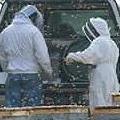 非營利組織自然資源保護委員會(NRDC)在8月18日向華盛頓聯邦法庭提告,要求美國聯邦政府公佈新殺蟲劑對蜜蜂影響的相關研究。這些關於農藥「可尼丁」(clothianidin)的研究,是由美國環保署針對製造商拜耳公司所做的調查報告。拜耳公司在2003年由美國聯邦政府機構獲准製造可尼丁。
非營利組織自然資源保護委員會(NRDC)在8月18日向華盛頓聯邦法庭提告,要求美國聯邦政府公佈新殺蟲劑對蜜蜂影響的相關研究。這些關於農藥「可尼丁」(clothianidin)的研究,是由美國環保署針對製造商拜耳公司所做的調查報告。拜耳公司在2003年由美國聯邦政府機構獲准製造可尼丁。
然而NRDC的蜜蜂研究專家和律師相信,美國環保署經過調查後,已有證據顯示殺蟲劑和「蜜蜂群衰竭失調症」(colony collapse disorder,CCD)──蜜蜂群相繼失蹤與死亡──的謎團有關,但是他們卻沒有將此訊息公諸於世。這項消息的重要性不容忽略,因為蜜蜂群傳粉攸關美國約九成作物,總值150億美金的商業利益,包括蘋果、桃、梨、南瓜、筍瓜、小黃瓜、櫻桃、胡椒、黃豆、杏仁、腰果和向日葵等,都需要蜜蜂的授粉來生長果實。
雖然NRDC提出《資訊公開法》,要求美國環保署釋出殺蟲劑對蜜蜂之毒性的相關研究紀錄,但至今該署仍未有任何回覆,使委員會不得已採取法律途徑。NRDC律師柯藍吉羅(Aaron Colangelo)表示:「近來發現那些核准使用的殺蟲劑和大量相繼死亡的蜂群大有關聯,這成為科學緝兇的重點。美國環保署在核准新殺蟲劑前,有責評估對蜜蜂造成傷害的風險,但他們卻拒絕告訴大眾這些相關資訊。法令限制殺蟲劑將是解決惡化危機的核心,既然決策需要這些相關資訊,為何不將它們透明化呢?」
罪魁禍首的嫌疑犯之一是可尼丁,一種新型的新菸鹼類(neonicotinoids)殺蟲劑,這類殺蟲劑會影響昆蟲的中樞神經系統。目前與賓州州立大學合作的昆蟲學家弗瑞茲(Maryann Frazier)根據一篇研究新菸鹼類殺蟲劑與蜜蜂的論文表示:「關於新菸鹼類殺蟲劑對於蜜蜂影響的各方資料存有矛盾。事實上這類型殺蟲劑裡的不同化學物質對蜜蜂的毒性也不同,但是美國環保署只認定益達胺(imidacloprid)和可尼丁這兩種的毒性。」
她指出環保署在可尼丁藥物資訊裡是這麼說的:「蜜蜂群暴露在此藥品中有慢性中毒的危險,其他無特定目標的傳粉者也可能經由花蜜和花粉沾染可尼丁而中毒。而使蜜蜂暴露於慢性中毒的影響中,更包括了對幼蟲與蜂后生殖能力等致命性程度不等的效應。」
弗瑞茲補註,曾出現結合使用某種殺蟲劑和殺菌劑的計畫,但是北科羅萊納州立大學的實驗研究發現,有些新菸鹼類殺蟲劑和某些殺菌劑合成後的綜合藥效,對蜜蜂的毒性增加1000倍以上。
自2006年蜜蜂群衰竭失調症問題浮現後,至今美國已有三分之一的蜜蜂被認定為因此症死亡或失蹤。根據2008年5月美國蜜蜂養殖觀察會(Apiary Inspectors of America)公佈的研究調查,2007年9月至2008年3月之間蜂場共損失36%的蜜蜂,往年這段期間損失量是31%。
接著在2008年5月德國也下令禁止使用拜耳公司販售的「斗篷牌」(Poncho)殺蟲劑,因其含有可尼丁,但未獲准即上市。雖然拜耳公司聲稱這只是極少數的審核作業疏失,但事實上德國早已禁止所有包括可尼丁的新菸鹼類殺蟲劑。
此外,拜耳公司生產的另一種新菸鹼類殺蟲劑「益達胺」,最近也因法國和美國南達科塔州爆發蜜蜂群衰竭失調症而成為眾矢之的。南達科塔州的農民控告拜耳公司造成作物損失,而法國政府也明令禁止使用此藥於向日葵種子的耕作。科學家至今仍致力於蜜蜂群失調症的詳細原因,不過他們認為這肯定和殺蟲劑大有關係。
The nonprofit Natural Resources Defense Council filed a lawsuit Monday in federal court in Washington DC to force the federal government to disclose studies on the effect of a new pesticide on honey bees. Studies on the pesticide, clothianidin, were ordered by the U.S. Environmental Protection Agency from the pesticide's manufacturer, Bayer CropScience, in 2003 when the federal agency granted the company a registration for the chemical.
An NRDC bee researcher and the organization's attorneys believe that the EPA has evidence of connections between pesticides and the mysterious honey bee die-offs reported across the country called "colony collapse disorder," or CCD, that it has not made public. The connection is important because commercial honey bees pollinate about 90 of the country's crops, valued at $15 billion. Apples, peaches, pears, pumpkins, squash, cucumbers, cherries, berries, peppers, squash, soybeans, almonds, cashews, and sunflowers all require or benefit from honey bee pollination.
The EPA has failed to respond to the NRDC's Freedom of Information Act request for agency records concerning the toxicity of pesticides to bees, prompting Monday's legal action. "Recently approved pesticides have been implicated in massive bee die-offs and are the focus of increasing scientific scrutiny," said NRDC attorney Aaron Colangelo. "EPA should be evaluating the risks to bees before approving new pesticides, but now refuses to tell the public what it knows." "Pesticide restrictions might be at the heart of the solution to this growing crisis, so why hide the information they should be using to make those decisions?" Calangelo asked.
The EPA has issued a fact sheet on clothianidin, one of a relatively new class of insecticides known as neonicotinoids that impact the central nervous system of insects. Maryann Frazier, who works with Pennsylvania State University as an extension associate in entomology, says in a paper on neonicotinoids and bees that, "There is conflicting information about the affects of neonicotinoids on honey bees, and different chemicals in this class are known to vary in their toxicity to bees, however the EPA identifies both imidacloprid and clothianidin as highly toxic to honey bees."
The EPA fact sheet says of clothianidin, "It has the potential for toxic chronic exposure to honey bees, as well as other non-target pollinators through the translocation of clothianidin resides in nectar and pollen. In honey bees, the affects of this toxic chronic exposure may include lethal and/or sub-lethal effects in the larvae and reproductive effects on the queen."
In addition, says Frazier, "there is concern about the practice of combining certain insecticides and fungicides." She cites a North Carolina University study found that some neonicotinoids in combination with certain fungicides, synergized to increase the toxicity of the neonicotinoid to honey bees over 1,000 fold in lab studies.
Colony collapse disorder has claimed more than one-third of honey bees in the United States since it was first identified in 2006. A survey by the Apiary Inspectors of America published in May found that losses of honey bees nationwide topped 36 percent of managed hives between September 2007 and March 2008, compared to a 31 percent loss during the same period a year earlier.
The chemical is sold under the brand name "Poncho" by Bayer AG in Germany, where it was banned in May after an unauthorized release that Bayer blames on an "extremely rare" "application error." In fact, Germany banned the entire class of neonicotinoids.
Another Bayer neonicotinoid, imidacloprid, has been blamed in France and South Dakota for colony collapse disorder. In South Dakota, farmers are suing, and the French government has banned the chemical for use on sunflower seeds. Scientists have not yet pinned down the cause of colony collapse disorder but they believe it is linked in part to pesticides.
全文及圖片詳見:ENS




